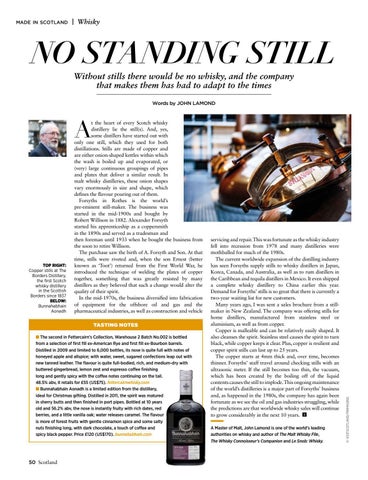MADE IN SCOTLAND
| Whisky
NO STANDING STILL Without stills there would be no whisky, and the company that makes them has had to adapt to the times Words by JOHN LAMOND
TOP RIGHT: Copper stills at The Borders Distillery, the first Scotch whisky distillery in the Scottish Borders since 1837 BELOW: Bunnahabhain Aonadh
TASTING NOTES ■ The second in Fettercairn’s Collection, Warehouse 2 Batch No.002 is bottled from a selection of first fill ex-American Rye and first fill ex-Bourbon barrels. Distilled in 2009 and limited to 6,000 bottles, its nose is quite full with notes of honeyed apple and allspice; with water, sweet, sugared confections leap out with new tanned leather. The flavour is quite full-bodied, rich, and medium-dry with buttered gingerbread, lemon zest and espresso coffee finishing long and gently spicy with the coffee notes continuing on the tail. 48.5% abv, it retails for £55 (US$75). fettercairnwhisky.com ■ Bunnahabhain Aonadh is a limited edition from the distillery, ideal for Christmas gifting. Distilled in 2011, the spirit was matured in sherry butts and then finished in port pipes. Bottled at 10 years old and 56.2% abv, the nose is instantly fruity with rich dates, red berries, and a little vanilla oak; water releases caramel. The flavour is more of forest fruits with gentle cinnamon spice and some salty nuts finishing long, with dark chocolate, a touch of coffee and spicy black pepper. Price £120 (US$170). bunnahabhain.com
50 Scotland
servicing and repair. This was fortunate as the whisky industry fell into recession from 1978 and many distilleries were mothballed for much of the 1980s. The current worldwide expansion of the distilling industry has seen Forsyths supply stills to whisky distillers in Japan, Korea, Canada, and Australia, as well as to rum distillers in the Caribbean and tequila distillers in Mexico. It even shipped a complete whisky distillery to China earlier this year. Demand for Forsyths’ stills is so great that there is currently a two-year waiting list for new customers. Many years ago, I was sent a sales brochure from a stillmaker in New Zealand. The company was offering stills for home distillers, manufactured from stainless steel or aluminium, as well as from copper. Copper is malleable and can be relatively easily shaped. It also cleanses the spirit. Stainless steel causes the spirit to turn black, while copper keeps it clear. Plus, copper is resilient and copper spirit stills can last up to 25 years. The copper starts at 4mm thick and, over time, becomes thinner. Forsyths’ staff travel around checking stills with an ultrasonic meter. If the still becomes too thin, the vacuum, which has been created by the boiling off of the liquid contents causes the still to implode. This ongoing maintenance of the world’s distilleries is a major part of Forsyths’ business and, as happened in the 1980s, the company has again been fortunate as we see the oil and gas industries struggling, while the predictions are that worldwide whisky sales will continue to grow considerably in the next 10 years. S A Master of Malt, John Lamond is one of the world’s leading authorities on whisky and author of The Malt Whisky File, The Whisky Connoisseur’s Companion and Le Snob: Whisky.
© VISITSCOTLAND/PRIMAGING
A
t the heart of every Scotch whisky distillery lie the still(s). And, yes, some distillers have started out with only one still, which they used for both distillations. Stills are made of copper and are either onion-shaped kettles within which the wash is boiled up and evaporated, or (very) large continuous groupings of pipes and plates that deliver a similar result. In malt whisky distilleries, these onion shapes vary enormously in size and shape, which defines the flavour pouring out of them. Forsyths in Rothes is the world’s pre-eminent still-maker. The business was started in the mid-1900s and bought by Robert Willison in 1882. Alexander Forsyth started his apprenticeship as a coppersmith in the 1890s and served as a tradesman and then foreman until 1933 when he bought the business from the soon to retire Willison. The purchase saw the birth of A. Forsyth and Son. At that time, stills were riveted and, when the son Ernest (better known as ‘Toot’) returned from the First World War, he introduced the technique of welding the plates of copper together, something that was greatly resisted by many distillers as they believed that such a change would alter the quality of their spirit. In the mid-1970s, the business diversified into fabrication of equipment for the offshore oil and gas and the pharmaceutical industries, as well as construction and vehicle

















